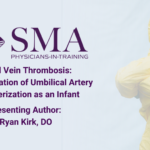Abstract | May 4, 2021
Portal Vein Thrombosis: A Complication of Umbilical Artery Catheterization as an Infant
Learning Objectives
- Identify the etiology of portal vein thrombosis and/or portal hypertension in patients with a history of umbilical vein catheterization.
Introduction:
This case represents a rare yet important adverse outcome to umbilical artery catheterization in a newborn. This case demonstrates the lifelong effects that can be had after this procedure and provides caution to those performing the procedure.
Case Presentation:
This patient is a 23 year old female with past history of premature birth at 27 weeks gestation, portal vein thrombosis and portal hypertension presented to hospital for acute large-volume hematemesis. Patient has experienced this three times previously and had EGD banding done two years ago. Patient’s physical exam was remarkable for spleen palpable at mid abdomen. No hepatomegaly appreciated on exam. Labs significant for Hemoglobin of 6.5 and Hematocrit of 20. Patient states she is not sure why she developed portal vein thrombosis and denies any other history of blood clots. Denies history of alcohol use.
Final/Working Diagnosis:
Differential diagnosis consisted of esophageal varies vs Boerhaave Syndrome vs Mallory Weiss Tear vs Gastric Ulcer Differential for cause of her portal vein thrombosis consist of hyper coagulable state (such as prothrombotic condition, malignancy, etc), liver cirrhosis or local infection/inflammation to the portal vein area.
Management/Outcome/Follow up:
Patient found to have negative work-up for any hyper coagulable condition and had two liver biopsies that were negative for cirrhosis. As no other source of thrombosis was identified, umbilical vein catheterization as a newborn was determined to be the most likely source for portal vein thrombosis in this patient. Patient during this admission, after initial resuscitation, had EGD with banding and left hospital in stable condition. Patient subsequently had splenorenal shunt placement and will potentially get splenectomy in the future.

